 |
 |
Our enthusiastic and extremely knowledgeable perennials team is here to answer your questions and help you choose the best perennials for your situation. There’s always something in bloom for sun, shade, butterflies, birds or deer resistance as well as a variety of bulbs for your space.
Stroll through our time-tested favorites and introduce yourself to the newest varieties. We garden with perennials too; we love them and it shows!
|
30 found, showing page 2 of 2
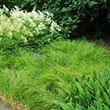
Low, clumping, chartreuse grass-like foliage. Naturalizing. Native. USDA 3-8
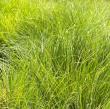
Dense, mounding, native variety. Wonderful when planted in masses. USDA 3-8
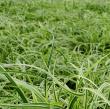
Plant Height: 12 inches
Flower Height: 18 inches
Spread: 18 inches
Sunlight: full sun, partial shade, full shade
Hardiness Zone: 4b
Other Names: Japanese Grass Sedge, Rush
Description:
Grown for delicate ornamental light-green and cream variegated foliage; great in a moist border in shade or sun, does not like to dry out
Ornamental Features:
Silver Sceptre Variegated Japanese Sedge is primarily valued in the garden for its cascading habit of growth. Its attractive grassy leaves remain light green in color with distinctive creamy white edges throughout the year.
Landscape Attributes:
Silver Sceptre Variegated Japanese Sedge is an herbaceous evergreen perennial grass with a shapely form and gracefully arching stems. Its relatively fine texture sets it apart from other garden plants with less refined foliage.
This is a relatively low maintenance plant, and is best cleaned up in early spring before it resumes active growth for the season. Deer don't particularly care for this plant and will usually leave it alone in favor of tastier treats. It has no significant negative characteristics.
Silver Sceptre Variegated Japanese Sedge is recommended for the following landscape applications:
- Mass Planting
- Border Edging
- General Garden Use
- Groundcover
- Naturalizing And Woodland Gardens
- Container Planting
Planting & Growing:
Silver Sceptre Variegated Japanese Sedge will grow to be about 12 inches tall at maturity extending to 18 inches tall with the flowers, with a spread of 18 inches. Its foliage tends to remain dense right to the ground, not requiring facer plants in front. It grows at a medium rate, and under ideal conditions can be expected to live for approximately 10 years. As an evegreen perennial, this plant will typically keep its form and foliage year-round.
This plant performs well in both full sun and full shade. It prefers to grow in moist to wet soil, and will even tolerate some standing water. It is not particular as to soil type or pH. It is somewhat tolerant of urban pollution. This is a selected variety of a species not originally from North America. It can be propagated by division; however, as a cultivated variety, be aware that it may be subject to certain restrictions or prohibitions on propagation.
Silver Sceptre Variegated Japanese Sedge is a fine choice for the garden, but it is also a good selection for planting in outdoor pots and containers. It is often used as a 'filler' in the 'spiller-thriller-filler' container combination, providing a canvas of foliage against which the thriller plants stand out. Note that when growing plants in outdoor containers and baskets, they may require more frequent waterings than they would in the yard or garden.
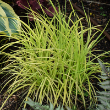
Plant Height: 18 inches
Flower Height: 24 inches
Spread: 18 inches
Sunlight: full sun, partial shade
Hardiness Zone: 4b
Other Names: Tufted Sedge, Bowles' Golden Grass
Description:
This sedge has spectacular bright gold-yellow foliage with thin green margins and is taller than most others; an excellent choice as a highlight plant for a shade or water garden; moisture loving and needs to be constantly wet or moist to thrive
Ornamental Features:
Bowles' Golden Sedge is primarily valued in the garden for its cascading habit of growth. Its attractive grassy leaves emerge lime green in spring, turning yellow in color with prominent green stripes. The foliage often turns brown in fall. The tan seed heads are carried on plumes in late summer.
Landscape Attributes:
Bowles' Golden Sedge is an herbaceous perennial grass with a shapely form and gracefully arching stems. It brings an extremely fine and delicate texture to the garden composition and should be used to full effect.
This is a relatively low maintenance plant, and is best cleaned up in early spring before it resumes active growth for the season. It has no significant negative characteristics.
Bowles' Golden Sedge is recommended for the following landscape applications:
- Mass Planting
- Border Edging
- General Garden Use
- Groundcover
- Container Planting
- Bog Gardens
Planting & Growing:
Bowles' Golden Sedge will grow to be about 18 inches tall at maturity extending to 24 inches tall with the flowers, with a spread of 18 inches. Its foliage tends to remain dense right to the ground, not requiring facer plants in front. It grows at a slow rate, and under ideal conditions can be expected to live for approximately 10 years. As an herbaceous perennial, this plant will usually die back to the crown each winter, and will regrow from the base each spring. Be careful not to disturb the crown in late winter when it may not be readily seen!
This plant does best in full sun to partial shade. It prefers to grow in moist to wet soil, and will even tolerate some standing water. It is not particular as to soil type or pH. It is somewhat tolerant of urban pollution. Consider applying a thick mulch around the root zone in both summer and winter to conserve soil moisture and protect it in exposed locations or colder microclimates. This is a selected variety of a species not originally from North America. It can be propagated by division; however, as a cultivated variety, be aware that it may be subject to certain restrictions or prohibitions on propagation.
Bowles' Golden Sedge is a fine choice for the garden, but it is also a good selection for planting in outdoor pots and containers. It can be used either as 'filler' or as a 'thriller' in the 'spiller-thriller-filler' container combination, depending on the height and form of the other plants used in the container planting. Note that when growing plants in outdoor containers and baskets, they may require more frequent waterings than they would in the yard or garden.
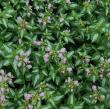
Pink blooms. Green leaves have white diamond. Groundcover. USDA 3-8
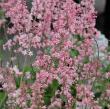
Known for its large, palmate leaves. Tall stalks of pinkish-white flowers in spring. USDA 4-9
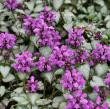
Dense spikes of rich purple flowers that appear above bright silvery foliage. USDA 3-8
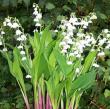
Plants form a spreading clump of large green leaves, bearing short spikes of fragrant white bells in late spring. Takes a year or two to establish, then spreads quickly. USDA 3-8
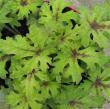
Deeply-lobed, green foliage is accented with dark-purple streaks. White flowers in spring. USDA 4-9
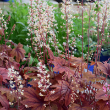
Height: 26 inches
Spacing: 24 inches
Sunlight: partial shade, full shade
Hardiness Zone: 4a
Description:
A vigorous shade plant with dainty flowers and stunning foliage; beautiful orange leaves with prominent burgundy centers and veins; an excellent color accent for the garden or containers
Ornamental Features:
Sweet Tea Foamy Bells is primarily valued in the garden for its distinctive form, with the flower stalks towering over the foliage. It features dainty spikes of creamy white bell-shaped flowers rising above the foliage from mid spring to early summer. The flowers are excellent for cutting. Its attractive deeply cut lobed leaves remain coppery-bronze in color with distinctive burgundy veins throughout the year. The black stems can be quite attractive.
Landscape Attributes:
Sweet Tea Foamy Bells is a dense herbaceous evergreen perennial with tall flower stalks held atop a low mound of foliage. Its relatively fine texture sets it apart from other garden plants with less refined foliage.
This is a relatively low maintenance plant, and should be cut back in late fall in preparation for winter. It is a good choice for attracting hummingbirds to your yard. It has no significant negative characteristics.
Sweet Tea Foamy Bells is recommended for the following landscape applications:
- Mass Planting
- Rock/Alpine Gardens
- Border Edging
- General Garden Use
- Groundcover
- Container Planting
- Planting & Growing
Sweet Tea Foamy Bells will grow to be about 20 inches tall at maturity, with a spread of 28 inches. When grown in masses or used as a bedding plant, individual plants should be spaced approximately 24 inches apart. Its foliage tends to remain dense right to the ground, not requiring facer plants in front. It grows at a medium rate, and under ideal conditions can be expected to live for approximately 10 years. As an evegreen perennial, this plant will typically keep its form and foliage year-round.
This plant does best in partial shade to shade. It prefers to grow in average to moist conditions, and shouldn't be allowed to dry out. It is not particular as to soil type or pH. It is somewhat tolerant of urban pollution. Consider applying a thick mulch around the root zone in winter to protect it in exposed locations or colder microclimates. This particular variety is an interspecific hybrid. It can be propagated by division; however, as a cultivated variety, be aware that it may be subject to certain restrictions or prohibitions on propagation.
Sweet Tea Foamy Bells is a fine choice for the garden, but it is also a good selection for planting in outdoor pots and containers. With its upright habit of growth, it is best suited for use as a 'thriller' in the 'spiller-thriller-filler' container combination; plant it near the center of the pot, surrounded by smaller plants and those that spill over the edges. Note that when growing plants in outdoor containers and baskets, they may require more frequent waterings than they would in the yard or garden.
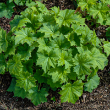
Plant Height: 24 inches
Flower Height: 3 feet
Spacing: 20 inches
Sunlight: full sun partial shade full shade
Hardiness Zone: 4a
Other Names: Maple Leaf Alumroot, Coralbells
Description:
Airy spikes of creamy bells rise from a large, dense mound of cup shaped, ruffled green foliage, great versatility; keep soil moist in heat of summer
Ornamental Features:
Autumn Bride Hairy Alumroot features showy spikes of creamy white bell-shaped flowers rising above the foliage in mid summer. Its attractive large crinkled lobed leaves remain green in color throughout the year.
Landscape Attributes:
Autumn Bride Hairy Alumroot is a dense herbaceous evergreen perennial with tall flower stalks held atop a low mound of foliage. Its relatively fine texture sets it apart from other garden plants with less refined foliage.
This is a relatively low maintenance plant, and should be cut back in late fall in preparation for winter. It is a good choice for attracting hummingbirds to your yard. It has no significant negative characteristics.
Autumn Bride Hairy Alumroot is recommended for the following landscape applications:
- Mass Planting
- Rock/Alpine Gardens
- Border Edging
- General Garden Use
- Groundcover
- Container Planting
- Planting & Growing
Autumn Bride Hairy Alumroot will grow to be about 24 inches tall at maturity extending to 3 feet tall with the flowers, with a spread of 24 inches. When grown in masses or used as a bedding plant, individual plants should be spaced approximately 20 inches apart. Its foliage tends to remain dense right to the ground, not requiring facer plants in front. It grows at a medium rate, and under ideal conditions can be expected to live for approximately 10 years. As an evegreen perennial, this plant will typically keep its form and foliage year-round.
This plant performs well in both full sun and full shade. However, you may want to keep it away from hot, dry locations that receive direct afternoon sun or which get reflected sunlight, such as against the south side of a white wall. It prefers to grow in average to moist conditions, and shouldn't be allowed to dry out. It is not particular as to soil type or pH. It is somewhat tolerant of urban pollution. Consider applying a thick mulch around the root zone in winter to protect it in exposed locations or colder microclimates. This is a selection of a native North American species. It can be propagated by division; however, as a cultivated variety, be aware that it may be subject to certain restrictions or prohibitions on propagation.
Autumn Bride Hairy Alumroot is a fine choice for the garden, but it is also a good selection for planting in outdoor pots and containers. With its upright habit of growth, it is best suited for use as a 'thriller' in the 'spiller-thriller-filler' container combination; plant it near the center of the pot, surrounded by smaller plants and those that spill over the edges. It is even sizeable enough that it can be grown alone in a suitable container. Note that when growing plants in outdoor containers and baskets, they may require more frequent waterings than they would in the yard or garden.
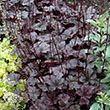
Plant Height: 6 inches
Flower Height: 12 inches
Spacing: 10 inches
Sunlight: full sun, partial shade, full shade
Hardiness Zone: 4a
Other Names: Coralbells, Alumroot
Description:
Beautiful plum-purple foliage with silvery overtones create tight mounds, perfect for beds, borders, containers and rock gardens; creamy white flower spikes contrast against dark and moody foliage; flowers are suitable for cutting
Ornamental Features:
Plum Pudding Coral Bells features dainty spikes of creamy white bell-shaped flowers rising above the foliage from late spring to early summer. Its attractive crinkled lobed leaves remain purple in color with distinctive deep purple veins and tinges of silver throughout the year.
Landscape Attributes:
Plum Pudding Coral Bells is a dense herbaceous evergreen perennial with tall flower stalks held atop a low mound of foliage. Its relatively fine texture sets it apart from other garden plants with less refined foliage.
This is a relatively low maintenance plant, and should be cut back in late fall in preparation for winter. It is a good choice for attracting hummingbirds to your yard. It has no significant negative characteristics.
Plum Pudding Coral Bells is recommended for the following landscape applications:
- Mass Planting
- Rock/Alpine Gardens
- Border Edging
- General Garden Use
- Groundcover
- Container Planting
- Planting & Growing
Plum Pudding Coral Bells will grow to be only 6 inches tall at maturity extending to 12 inches tall with the flowers, with a spread of 12 inches. When grown in masses or used as a bedding plant, individual plants should be spaced approximately 10 inches apart. Its foliage tends to remain low and dense right to the ground. It grows at a medium rate, and under ideal conditions can be expected to live for approximately 10 years. As an evegreen perennial, this plant will typically keep its form and foliage year-round.
This plant performs well in both full sun and full shade. However, you may want to keep it away from hot, dry locations that receive direct afternoon sun or which get reflected sunlight, such as against the south side of a white wall. It prefers to grow in average to moist conditions, and shouldn't be allowed to dry out. It is not particular as to soil type or pH. It is somewhat tolerant of urban pollution. Consider covering it with a thick layer of mulch in winter to protect it in exposed locations or colder microclimates. This particular variety is an interspecific hybrid. It can be propagated by division; however, as a cultivated variety, be aware that it may be subject to certain restrictions or prohibitions on propagation.
Plum Pudding Coral Bells is a fine choice for the garden, but it is also a good selection for planting in outdoor pots and containers. It is often used as a 'filler' in the 'spiller-thriller-filler' container combination, providing a mass of flowers and foliage against which the larger thriller plants stand out. Note that when growing plants in outdoor containers and baskets, they may require more frequent waterings than they would in the yard or garden.
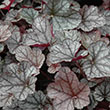
Plant Height: 15 inches
Flower Height: 24 inches
Spacing: 10 inches
Sunlight: full sun, partial shade, full shade
Hardiness Zone: 4a
Other Names: Coralbells, Alumroot
Description:
Creamy bells rise from compact mounds of silvery and purple foliage with dark purple and green veins; amazing contrast to other plants;great versatility; keep soil moist in heat of summer
Ornamental Features:
Silver Scrolls Coral Bells is primarily valued in the garden for its distinctive form, with the flower stalks towering over the foliage. It features tiny spikes of creamy white bell-shaped flowers rising above the foliage from mid to late summer. Its attractive crinkled lobed leaves remain silver in color with distinctive deep purple veins and tinges of green throughout the year.
Landscape Attributes:
Silver Scrolls Coral Bells is a dense herbaceous evergreen perennial with tall flower stalks held atop a low mound of foliage. Its relatively fine texture sets it apart from other garden plants with less refined foliage.
This is a relatively low maintenance plant, and should be cut back in late fall in preparation for winter. It is a good choice for attracting hummingbirds to your yard. It has no significant negative characteristics.
Silver Scrolls Coral Bells is recommended for the following landscape applications:
- Mass Planting
- Rock/Alpine Gardens
- Border Edging
- General Garden Use
- Groundcover
- Container Planting
- Planting & Growing
Silver Scrolls Coral Bells will grow to be about 15 inches tall at maturity extending to 24 inches tall with the flowers, with a spread of 12 inches. When grown in masses or used as a bedding plant, individual plants should be spaced approximately 10 inches apart. Its foliage tends to remain dense right to the ground, not requiring facer plants in front. It grows at a medium rate, and under ideal conditions can be expected to live for approximately 10 years. As an evegreen perennial, this plant will typically keep its form and foliage year-round.
This plant performs well in both full sun and full shade. However, you may want to keep it away from hot, dry locations that receive direct afternoon sun or which get reflected sunlight, such as against the south side of a white wall. It prefers to grow in average to moist conditions, and shouldn't be allowed to dry out. It is not particular as to soil type or pH. It is somewhat tolerant of urban pollution. Consider applying a thick mulch around the root zone in winter to protect it in exposed locations or colder microclimates. This particular variety is an interspecific hybrid. It can be propagated by division; however, as a cultivated variety, be aware that it may be subject to certain restrictions or prohibitions on propagation.
Silver Scrolls Coral Bells is a fine choice for the garden, but it is also a good selection for planting in outdoor pots and containers. With its upright habit of growth, it is best suited for use as a 'thriller' in the 'spiller-thriller-filler' container combination; plant it near the center of the pot, surrounded by smaller plants and those that spill over the edges. Note that when growing plants in outdoor containers and baskets, they may require more frequent waterings than they would in the yard or garden.
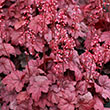
Red foliage matures to purple. Lilac blooms. USDA 4-9
30 found, showing page 2 of 2







